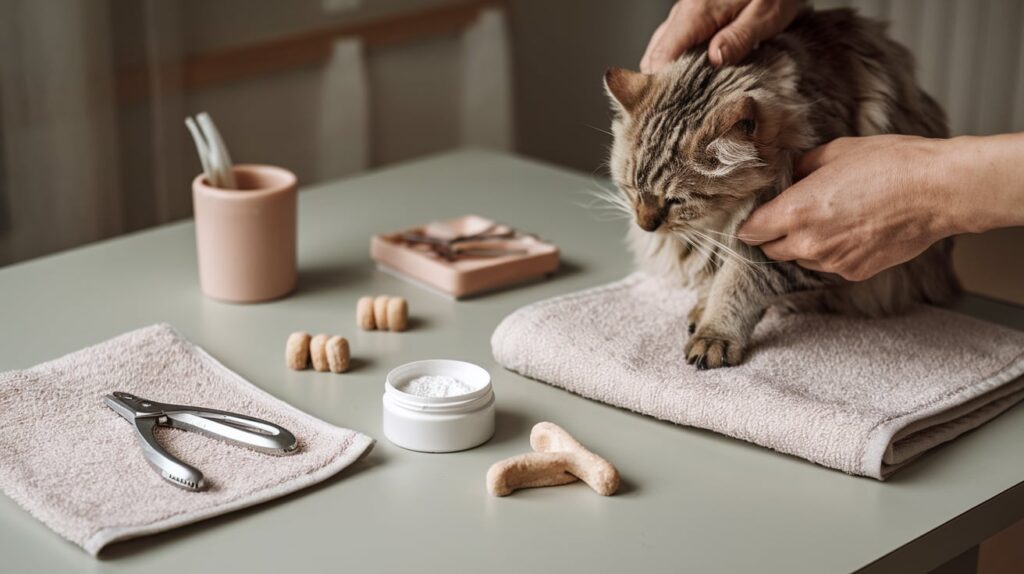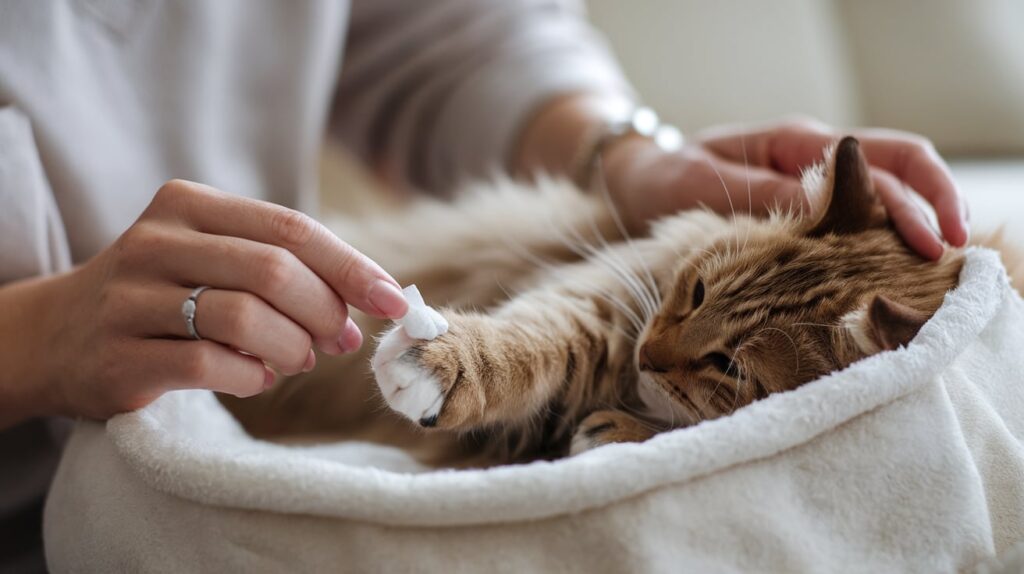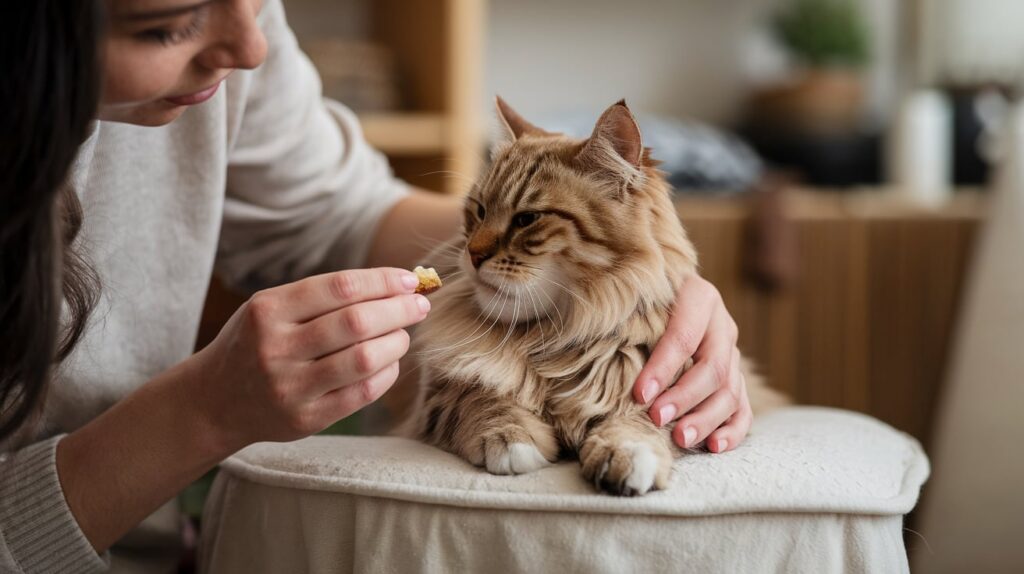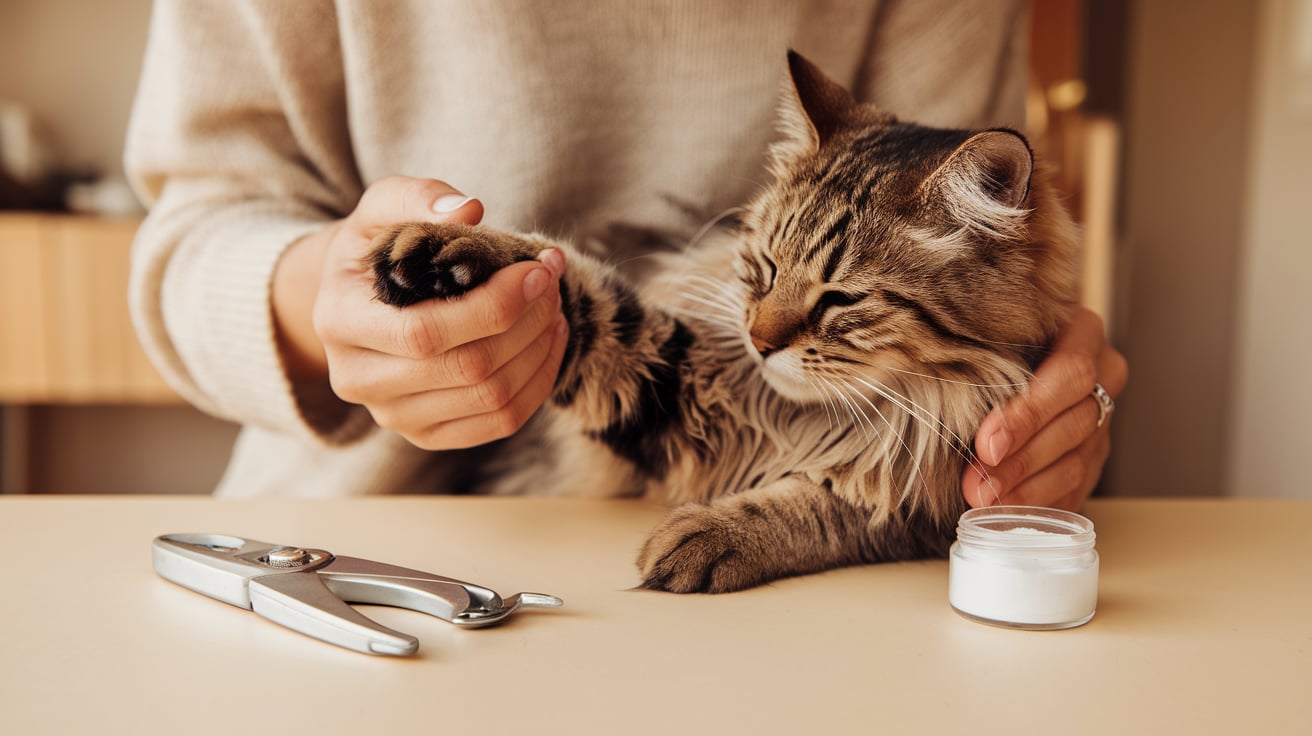Introduction
Caring for a cat involves more than just providing food and affection; grooming plays an essential role in their well-being, and one often overlooked aspect of this is “How to Trim Cat Nails by Yourself.” Regularly trimming a cat’s nails is crucial not only for their comfort but also for their health. Cats naturally use their claws for scratching, climbing, and playing, but when their nails grow too long, they can cause discomfort, injury, or damage to both the cat and its surroundings. While some owners may feel nervous about trimming their pet’s nails, understanding its benefits can make it easier to incorporate into routine care.
Trimming a cat’s nails offers several advantages. From a health standpoint, it prevents nails from becoming overgrown, which can cause painful conditions like ingrown nails or infections. Additionally, shorter nails reduce the risk of accidental scratches that may harm both the cat and others around them. It also helps prevent damage to household furniture, curtains, and carpets, a common concern for many pet owners. Safety-wise, regularly clipped nails can reduce the risk of a cat getting their claws caught in fabrics, reducing potential injury.
However, many people shy away from trimming their cat’s nails due to fear or misconceptions. Some believe the process is painful for the cat, while others worry about cutting too far and causing bleeding. In reality, with the right tools and a gentle approach, nail trimming is relatively easy and safe. Patience and practice can help both the cat and the owner become more comfortable with the process, debunking the myth that it’s a stressful or harmful task.
Tools You’ll Need
Before you begin trimming your cat’s nails, it’s important to have the right tools on hand to ensure the process goes smoothly and safely. One of the most essential tools is a pair of cat nail clippers. While some people use human nail clippers, it is generally preferable to use clippers made specifically for cats. Cat clippers are shaped to accommodate the natural curve of a cat’s claw, making it easier to get a clean cut without causing discomfort. They come in various styles, such as scissor-like clippers or guillotine types, and you can choose whichever feels most comfortable for you and your cat.

Accidents can happen, especially if your cat is wiggly or if you’re still getting the hang of the process. Having styptic powder or cornstarch nearby is a good safety measure. These can quickly stop bleeding in case you accidentally trim too close to the quick, which is the sensitive area inside the nail. A small dab of styptic powder can help the bleeding stop almost immediately and prevent any infection, giving you peace of mind.
Lastly, treats and positive reinforcement play a key role in making nail trimming a positive experience for your cat. Offering a treat before and after the trimming session helps build a connection between the experience and something pleasant, making your cat more cooperative in the future. If your cat tends to be extra nervous or fidgety, you might also want to have a towel handy to gently wrap and restrain them. This helps to keep them calm and prevents sudden movements that could lead to accidental cuts.
Preparation: Setting the Scene
Before you begin trimming your cat’s nails, it’s essential to create a calm and stress-free environment. Choose a quiet room with minimal distractions where your cat feels safe. Avoid areas with sudden noises or a lot of foot traffic, as this can make your cat nervous. Ensuring a peaceful setting will help your cat feel more at ease, making the process smoother for both of you. A stress-free environment can also prevent your cat from becoming startled or anxious, reducing the chances of sudden movements that might make trimming difficult.

Timing is another crucial factor in successful nail trimming. It’s best to attempt it when your cat is already feeling relaxed—ideally after a meal or a good play session. A cat that’s just eaten or had some exercise is usually more content and less likely to resist being handled. Additionally, spending time desensitizing your cat to having their paws touched can make the process much easier in the long run. You can start by gently handling your cat’s paws during cuddle sessions, softly pressing on their pads to extend the claws without actually trimming them. This practice helps your cat get used to the sensation and reduces anxiety when it’s time for the actual trim.
Having all your tools within easy reach before starting is a key part of preparation. Lay out the nail clippers, styptic powder, treats, and a towel (if needed) where they’re easily accessible. This way, you won’t have to interrupt the session to search for something, that could stress your cat or make them lose its patience. Being well-prepared creates a smoother experience and builds confidence for both you and your cat.
Step-by-Step Guide to Trimming Cat Nails
Position your cat – Holding techniques:
Before you start trimming, it’s important to position your cat in a way that makes both of you feel comfortable and safe. One of the easiest techniques is to place your cat on your lap with their belly facing up. This allows you to have a clear view of their paws and makes it easier to reach the nails. If your cat tends to be more nervous or resistant, you can gently wrap them in a towel, leaving only one paw exposed at a time. This method helps them feel secure while preventing sudden movements.
Inspect the nails – Identify the quick:
Before you begin trimming, take a moment to inspect each nail carefully. Cat nails are somewhat transparent, allowing you to see the quick, which is the pinkish part of the nail containing blood vessels and nerves. It’s important to avoid cutting too close to the quick, as this can cause pain and bleeding. Identifying the quick will guide you in making a safe cut and ensuring that only the sharp tip is trimmed.
Clip the nails:
To trim the nails, gently hold your cat’s paw and press down lightly on the pad to extend the nail fully. Once the claw is visible, position the clippers and cut just the sharp tip of the nail, staying well away from the quick. It’s best to take small snips if you’re unsure, rather than cutting too much at once. Repeat this process for each nail, making sure to include the dewclaws, which are located on the inner side of the front paws and can grow longer than the others.
Stay calm and take breaks if necessary:
Throughout the process, it’s important to stay calm and patient. If your cat becomes restless or anxious, feel free to take a break. This will help prevent any accidental cuts or stress. Offering praise or treats after each nail is clipped can make the experience more positive and help build trust between you and your cat. Taking your time and staying composed will create a smoother experience for both of you.
What to do if you accidentally cut the quick?
How to stop bleeding
If you accidentally cut the quick, it’s important to address the situation quickly to minimize discomfort and prevent further issues. First, apply styptic powder or cornstarch directly to the nail where the bleeding is occurring. These substances help to quickly stop the bleeding by causing the blood vessels to constrict. Simply press the powder or cornstarch onto the nail and hold it in place for a few moments. This should help to clot the blood and stop the bleeding. If you don’t have styptic powder or cornstarch on hand, you can use a clean cloth to gently apply pressure to the nail until the bleeding stops.

Give your cat time to relax
After an accidental cut, it’s crucial to help your cat calm down and recover. Gently soothe your cat with a soft voice and reassuring petting. Give them some time to relax in a quiet, comfortable space. If your cat is feeling particularly stressed or agitated, it may be helpful to let them rest in a favorite spot or offer a treat to comfort them. Ensuring that they feel safe and secure will help them recover from the experience and make future nail-trimming sessions easier.
Monitor the nail for signs of infection
Once the bleeding has stopped, keep an eye on the nail over the next few days to ensure it heals properly. Look for signs of infection, such as increased redness, swelling, or discharge. If you detect any of these signs, you should speak with your veterinarian to ensure appropriate treatment. Regular monitoring will allow you to identify possible problems early and keep your cat’s nails healthy and pain-free.
Positive Reinforcement and Aftercare
Reward your cat with food and praise after each session
Positive reinforcement is key to making nail trimming a more pleasant experience for your cat. After each successful trimming session, be sure to reward your cat with their favorite treats and plenty of praise. This not only helps your cat associate nail trimming with positive experiences but also encourages them to remain calm and cooperative in the future. Gentle strokes and soothing words can go a long way in reinforcing good behavior and creating a more positive environment for both of you.

Gradually increase the number of nails trimmed per session:
It’s important to gradually build up your cat’s tolerance for nail trimming. Start by trimming just a few nails at a time, especially if your cat is new to the process or tends to get anxious. As your cat becomes more accustomed to having their nails trimmed, you can gradually increase the number of nails you trim in each session. This incremental approach helps to prevent overwhelming your cat and allows them to adjust at their own pace, making the process smoother over time.
End the session on a positive note, even if you don’t finish all the nails:
If you find that your cat becomes restless or agitated during the session, it’s better to stop and end on a positive note rather than push through. Even if you haven’t managed to trim all of the nails, providing a reward and praise for the progress you’ve made will help your cat associate nail trimming with positive experiences. Ending the session positively can help your cat look forward to future trims and reduce their anxiety over time.
How Often to Trim Your Cat’s Nails
The frequency of trimming your cat’s nails can vary depending on their lifestyle and activity level. Generally, it’s recommended to trim your cat’s nails every 2 to 4 weeks. Cats that spend a lot of time outdoors or are very active may naturally wear down their nails and may need less frequent trims. Conversely, indoor cats or those with less activity might require more regular attention. Regular trimming helps to keep their nails at a comfortable length and reduces the risk of overgrowth, which can lead to health issues or damage to furniture and flooring.
To determine when your cat’s nails need trimming, observe their claws regularly. If you notice that the nails are becoming long enough to curl or that your cat’s claws are making a clicking sound on hard surfaces, it’s time for a trim. Long nails can cause discomfort, affect your cat’s walking, and even lead to painful conditions like ingrown nails. Keeping an eye on these signs and maintaining a consistent trimming schedule helps ensure your cat’s nails remain healthy and manageable.
When to Seek Professional Help
If you encounter behavioral challenges or find that your cat becomes too stressed during nail trimming, it might be time to seek professional help. Some cats have a strong aversion to having their nails trimmed and may become overly anxious or aggressive, making the process difficult and stressful for both of you. If you find it challenging to manage your cat’s behavior or if your attempts at trimming are causing significant distress, consulting with a professional can provide a solution.
Alternatives include visiting a groomer or your veterinarian, both of whom are experienced in handling cats and can provide nail trimming services. Professional groomers are skilled in managing different cat temperaments and can often handle nervous or fidgety cats with ease. Similarly, your vet can trim your cat’s nails and offer additional advice or treatment if there are underlying issues. Seeking professional help ensures that your cat’s nails are trimmed safely and can also help alleviate any stress or discomfort associated with the process. If your cat is meowing regularly then you must check her nails.
Conclusion
Maintaining the overall health and comfort of your cat depends heavily on regular nail cutting. It helps prevent issues like overgrown nails, painful conditions, and damage to your home. By keeping your cat’s nails at a manageable length, you can ensure they move comfortably, avoid painful injuries, and keep your furniture and flooring in better condition.
The secret to becoming skilled at nail trimming is practice and patience. Even while it could appear frightening at first, you’ll gain confidence and efficiency with time and expertise. Remember, creating a positive experience for your cat through gentle handling and rewards will help make future trimming sessions smoother and less stressful. Consistent care and a calm approach will not only benefit your cat’s well-being but also strengthen the bond between you and your feline friend.
Questions
How can I tell if my cat’s nails are too long?
You can check if your cat’s nails are too long by observing their behavior and the appearance of the nails. If the nails are curling downward or making a clicking sound on hard surfaces, they may be too long. Additionally, if your cat’s claws are visibly extended and sharp, it’s time for a trim. Regular inspections will help you keep track of their nail length.
What if my cat doesn’t like having their nails trimmed?
If your cat is resistant to having their nails trimmed, try to desensitize them by gently handling their paws during non-trimming times. You can also start by trimming just one or two nails at a time and gradually increase the number as your cat becomes more comfortable. Using treats and positive reinforcement can help create a positive association with the process. If these methods don’t work, consider seeking professional help from a groomer or veterinarian.
Is it necessary to trim my cat’s dewclaws?
Yes, it is important to trim your cat’s dewclaws, which are located on the inner side of the front paws. Dewclaws can grow longer than the other nails and may become overgrown if not trimmed regularly. Including them in your nail trimming routine helps ensure that all of your cat’s claws are kept at a healthy length.
What should I do if I accidentally cut the quick?
If you accidentally cut the quick and your cat starts to bleed, apply styptic powder or cornstarch to the affected nail to stop the bleeding. Press the powder onto the nail and hold it in place until the bleeding ceases. Calm your cat and give them time to relax. Keep an eye out for any indications of infection, like redness or swelling, and contact your veterinarian if needed.
How often should the nails on my cat be cut?
The lifestyle and activity level of your cat determines how often they should have their nails trimmed. Generally speaking, your cat’s nails should be trimmed every two to four weeks. Outdoor or active cats may naturally wear down their nails and may need less frequent trims, while indoor cats may require more regular attention.
Can I cut my cat’s nails with human nail clippers?
While you can use human nail clippers in a pinch, it’s better to use clippers specifically designed for cats. Cat nail clippers are shaped to accommodate the natural curve of a cat’s claws, making it easier to get a clean cut without causing discomfort. They are designed to handle the unique structure of feline nails more effectively than human clippers.
What if my cat has a nail infection?
If you suspect your cat has a nail infection, such as redness, swelling, or discharge, it’s important to consult your veterinarian. They can assess the condition of the nail and provide appropriate treatment, which may include antibiotics or other medications to address the infection and prevent further issues.
How can I make nail trimming less stressful for my cat?
To make nail trimming less stressful, create a calm environment, use treats and praise for positive reinforcement, and handle your cat’s paws regularly to get them accustomed to the sensation. Gradually increase the number of nails you trim per session and end on a positive note. If necessary, seek the help of a professional groomer or veterinarian to ease the process.
